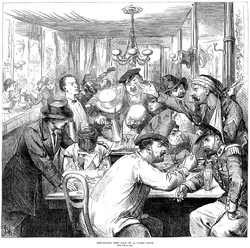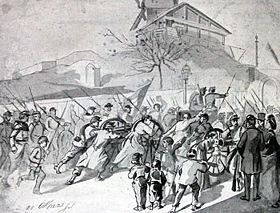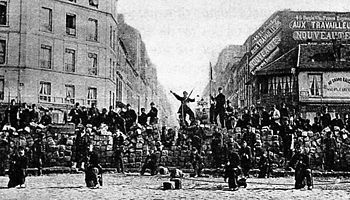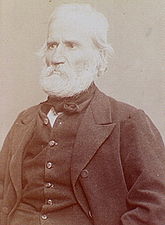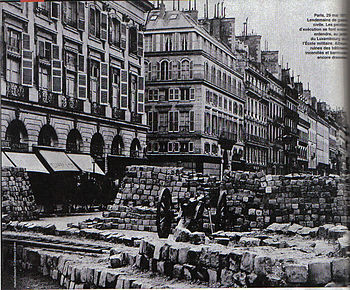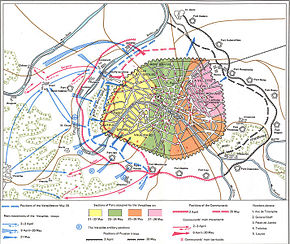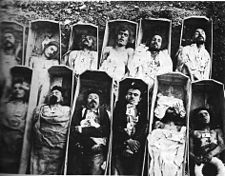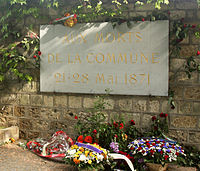- Paris Commune
-
This article is about the government of Paris in 1871. For the Commune during the French Revolution, see Paris Commune (French Revolution).
The Commune of Paris
La Commune de Paris← 
March 1871–May 1871  →
→Capital Paris1 Language(s) French Religion secular Government Commune Historical era Spring of 1871 - Established 18 March 1871 - Disestablished 28 May 1871 1 The Paris Commune was a city-state.  Le Père Duchesne looking at the statue of Napoleon I on top of the Vendôme column: "Eh ben! Bougre de canaille, on va donc te foutre en bas comme ta crapule de neveu!… (Well now! Damn rascal, we will knock you down just like your crook of a nephew!…")
Le Père Duchesne looking at the statue of Napoleon I on top of the Vendôme column: "Eh ben! Bougre de canaille, on va donc te foutre en bas comme ta crapule de neveu!… (Well now! Damn rascal, we will knock you down just like your crook of a nephew!…")
The Paris Commune (French: La Commune de Paris, IPA: [la kɔmyn də paʁi]) was a government that briefly ruled Paris from March 18 (more formally, from March 28) to May 28, 1871. It existed before the split between anarchists and Marxists had taken place, and it is hailed by both groups as the first assumption of power by the working class during the Industrial Revolution. Debates over the policies and outcome of the Commune contributed to the break between those two political groups.
In a formal sense, the Paris Commune simply acted as the local authority, the city council (in French, the "commune"), which exercised power in Paris for two months in the spring of 1871. However, the conditions in which it formed, its controversial decrees, and its violent end make its tenure one of the more important political episodes of the time.
Contents
Background
The Commune was the result of an uprising in Paris after France was defeated in the Franco-Prussian War. This uprising was chiefly caused by the disaster in the war and the growing discontent among French workers.[1] The worker discontent can be traced to the first worker uprisings, the Canut Revolts, in Lyon and Paris in the 1830s[2] (a Canut was a Lyonnais silk worker, often working on Jacquard looms).
Parisians, especially workers and the lower-middle classes, had long supported a democratic republic. A specific demand was that Paris should be self-governing with its own elected council, something enjoyed by smaller French towns but denied to Paris by a national government wary of the capital's unruly populace. An associated, but less well-articulated, wish was for a more "just", if not necessarily socialist, way of managing the economy, summed up in the popular appeal for "la république démocratique et sociale!" ("the democratic and social republic!")
The war with Prussia, initiated by Napoleon III in July 1870, turned out disastrously for France, and by September Paris itself was under siege. The gap between rich and poor in the capital had widened during the preceding years, and then food shortages, military failures, and, finally, a Prussian bombardment of the city contributed to a widespread discontent. In January 1871, after four months of siege the moderate republican Government of National Defense sought an armistice with the newly-proclaimed German Empire. The Germans included a triumphal entry into Paris in their peace terms. Given the hardships of the siege, many Parisians were bitterly resentful of the Prussians (now at the head of the German Empire) being allowed even a brief ceremonial occupation of their city.
Hundreds of thousands of Parisians were armed members of a citizens' militia known as the "National Guard", which had been greatly expanded to help defend the city. Guard units elected their own officers, who, in working-class districts, included radical and socialist leaders.
Steps were taken to form a "Central Committee" of the Guard, including patriotic republicans and socialists, both to defend Paris against a possible German attack and also to defend the republic against a possible royalist restoration. The election of a monarchist majority to the new National Assembly in February 1871 made such fears seem plausible.
The population of Paris was defiant in the face of defeat and prepared to fight if the entry of the German army into the city should provoke them sufficiently. Before German troops entered Paris, National Guardsmen, helped by ordinary working people, managed to move large numbers of cannon (which they regarded as their own property because they had been partly paid-for by public subscription) away from the Germans' path and store them in "safe" districts. One of the chief "cannon parks" was on the heights of Montmartre.
Adolphe Thiers was elected "Executive Power" of the new government to postpone the issue of whether to have a president or king. Thiers, as head of the new provisional national government, realised that in the current unstable situation the Central Committee of the Guard formed an alternative centre of political and military power. He was also concerned that workers would arm themselves with the National Guard's weapons and provoke the Germans.
Rise and nature
The Germans entered Paris briefly and left again without incident, but Paris continued to be in a state of high political excitement. The newly elected National Assembly was in the process of moving to Bordeaux from Versailles (several miles south-west of Paris), having decided that the capital city was too turbulent for them to meet there. Their absence created a power vacuum in Paris as well as suspicion about the National Assembly's intentions, as it had a large royalist majority.
As the Central Committee of the National Guard adopted an increasingly radical stance and steadily gained authority, the government felt that it could not indefinitely allow it to have four hundred cannon at its disposal. So, as a first step, on March 18, 1871, Thiers ordered regular troops to seize the cannon stored on the Butte Montmartre and in other locations across the city. The soldiers, however, whose morale was low, fraternized with National Guards and local residents. The general at Montmartre, Claude Martin Lecomte, who was later said to have ordered them to fire on the crowd of National Guards and civilians, was dragged from his horse and later shot together with General Thomas, a veteran republican now hated as former commander of the National Guard, who was seized nearby.
Other army units joined the rebellion, which spread so fast that the head of the government, Thiers, ordered an immediate evacuation of Paris by as many of the regular forces as would obey, by the police, and by administrators and specialists of every kind. He fled ahead of them to Versailles. Thiers claimed he had thought about this strategy (to retreat from Paris, and crush the insurrection afterward) for a long time, while meditating on the example of the 1848 Revolution, but it is just as likely that he panicked. There is no evidence that the government had expected or planned for the crisis that had now begun. The Central Committee of the National Guard was now the only effective government in Paris; it arranged elections for a Commune, to be held on March 26.
The 92 members of the "Communal Council" included a high proportion of skilled workers and several professionals (such as doctors and journalists). Many of them were political activists, ranging from reformist republicans, through various types of socialists, to the Jacobins who tended to look back nostalgically to the Revolution of 1789.
The veteran leader of the 'Blanquist' group of revolutionary socialists, Louis Auguste Blanqui, was hoped by his followers to be a potential leader of the revolution, but he had been arrested on March 17 and was held in prison throughout the life of the Commune. The Commune unsuccessfully tried to exchange him, first against Georges Darboy, Archbishop of Paris, then against all 74 hostages it detained, but Thiers flatly refused (see below). The Paris Commune was proclaimed on March 28, although local districts often retained the organizations from the siege.
Social measures
The commune adopted the previously discarded French Republican Calendar during its brief existence and used the socialist red flag rather than the republican tricolour. In 1848, during the Second Republic, radicals and socialists had also adopted the red flag to distinguish themselves from moderate Republicans; this was similar to the symbolic distinctions adopted by the moderate, liberal, Girondist movement during the 1789 revolution.
Despite internal differences, the Council made a good start in organizing the public services essential for a city of two million. It also reached consensus on certain policies that tended towards a progressive, secular, and highly-democratic social democracy, rather than a true social revolution. Because the Commune was able to meet on fewer than sixty days in all, only a few decrees were actually implemented. These included:
- the separation of church and state;
- the remission of rents owed for the entire period of the siege (during which, payment had been suspended);
- the abolition of night work in the hundreds of Paris bakeries;
- the granting of pensions to the unmarried companions and children of National Guards killed on active service;
- the free return, by the city pawnshops, of all workmen's tools and household items valued up to 20 francs, pledged during the siege; the Commune was concerned that skilled workers had been forced to pawn their tools during the war;
- the postponement of commercial debt obligations, and the abolition of interest on the debts; and
- the right of employees to take over and run an enterprise if it were deserted by its owner; the Commune, nonetheless, recognized the previous owner's right to compensation.
The decrees separated the church from the state, made all church property public property, and excluded the practice of religion from schools. (After the fall of the Commune, separation of Church and State, or laïcité, would not enter French law again until 1880-81 during the Third Republic, with the signing of the Jules Ferry laws and the 1905 French law on the separation of Church and State.) The churches were allowed to continue their religious activity only if they kept their doors open for public political meetings during the evenings. Along with the streets and the cafés, the churches became centres for political discussions and activities.
Other projected legislation dealt with educational reforms that would make further education and technical training freely available to all.
 The Commune returns workmen's tools pawned during the siege
The Commune returns workmen's tools pawned during the siege
Feminist initiatives
Some women organized a feminist movement, following on from earlier attempts in 1789 and 1848. Thus, Nathalie Lemel, a socialist bookbinder, and Élisabeth Dmitrieff, a young Russian exile and member of the Russian section of the First International (IWA), created the Union des femmes pour la défense de Paris et les soins aux blessés ("Women's Union for the Defense of Paris and Care of the Injured") on April 11, 1871. The feminist writer André Léo, a friend of Paule Minck, was also active in the Women's Union. Believing that their struggle against patriarchy could only be pursued through a global struggle against capitalism, the association demanded gender equality, wages' equality, the right of divorce for women, the right to secular education and professional education for girls. They also demanded suppression of the distinction between married women and concubines, and between legitimate and illegitimate children. They advocated the abolition of prostitution (obtaining the closing of the maisons de tolérance, or legal official brothels). The Women's Union also participated in several municipal commissions and organized cooperative workshops.[3] Along with Eugène Varlin, Nathalie Le Mel created the cooperative restaurant La Marmite, which served free food for indigents, and then fought during the Bloody Week on the barricades.[4]
Paule Minck opened a free school in the Church of Saint Pierre de Montmartre and animated the Club Saint-Sulpice on the Left Bank.[4] The Russian Anne Jaclard, who declined to marry Dostoievsky and finally became the wife of Blanquist activist Victor Jaclard, founded the newspaper Paris Commune with André Léo. She was also a member of the Comité de vigilance de Montmartre, along with Louise Michel and Paule Minck, as well as of the Russian section of the First International. Victorine Brocher, close to the IWA activists, and founder of a cooperative bakery in 1867, also fought during the Commune and the Bloody Week.[4]
Famous figures such as Louise Michel, the "Red Virgin of Montmartre", who joined the National Guard and would later be sent to New Caledonia, symbolized the active participation of a small number of women in the insurrectionary events. A female battalion from the National Guard defended the Place Blanche during the repression.
Local organizations
The work-load of the Commune leaders was enormous. The Council members (who were not "representatives" but delegates, subject in theory to immediate recall by their electors) were expected to carry out many executive and military functions as well as their legislative ones. The numerous ad hoc organisations set up during the siege in the localities ("quartiers") to meet social needs (canteens and first aid stations, for example) continued to thrive and cooperate with the Commune.
At the same time, these local assemblies pursued their own goals, usually under the direction of local workers. Despite the formal reformism of the Commune council, the composition of the Commune as a whole was much more revolutionary. Revolutionary factions included Proudhonists (an early form of moderate anarchism), members of the international socialists, Blanquists, and more libertarian republicans. The Paris Commune has been celebrated by anarchists and Marxists ever since then, due to the variety of political undercurrents, the high degree of workers' control, and the remarkable co-operation among different revolutionists.
For example, in the third arrondissement, school materials were provided free, three parochial schools were "laicised", and an orphanage was established. In the twentieth arrondissement, school children were provided with free clothing and food. There were many similar examples, but a vital ingredient in the Commune's relative success, at this stage, was the initiative shown by ordinary workers who managed to take on the responsibilities of the administrators and specialists who had been removed by Thiers.
After only a week, the Commune came under attack by elements of the army (which eventually included former prisoners of war released by the Germans) being reinforced at a furious pace at Versailles.
Assault
The Commune forces, the National Guard, first began skirmishing with the regular Army of Versailles on April 2. Neither side really sought a major civil war, nor was either side ever willing to negotiate.

The nearby suburb of Courbevoie was occupied by the government forces on April 2, and a delayed attempt by the Commune's forces to march on Versailles on April 3 failed ignominiously. Defence and survival became overriding considerations, and the Commune leadership made a determined effort to turn the National Guard into an effective defense force.
Strong support also came from the large foreign community of political refugees and exiles in Paris: one of them, the Polish ex-officer and nationalist Jarosław Dąbrowski, was to be the Commune's best general. The Council was fully committed to internationalism, and in the name of brotherhood the Vendôme Column, celebrating the victories of Napoleon I, and considered by the Commune to be a monument to Bonapartism and chauvinism, was pulled down.
Abroad, there were rallies and messages of goodwill sent by trade union and socialist organisations, including some in Germany. But any hopes of getting serious help from other French cities were soon dashed. Thiers and his ministers in Versailles managed to prevent almost all information from leaking out of Paris; and in provincial and rural France there had always been a skeptical attitude towards the activities of the metropolis. Movements in Narbonne, Limoges, and Marseille were quickly crushed.
As the situation deteriorated further, a section of the Council won a vote (opposed by bookbinder Eugène Varlin, an associate of Michael Bakunin and correspondent of Karl Marx, and by other radicals) for the creation of a "Committee of Public Safety", modelled on the Jacobin organ with the same title, formed in 1792. Its powers were extensive and ruthless in theory, but in practice it was ineffective.
Throughout April and May, government forces, constantly increasing in number—with Prussia releasing French POWs to help the Thiers government—besieged the city's powerful defenses, and pushed back the National Guards. On May 21 a gate in the western part of the fortified city wall of Paris was opened, and Versaillese troops began the reconquest of the city. They first occupied the prosperous western districts, where they were welcomed by residents who had not left Paris after the armistice. It seems an engineer (who had spied regularly for the Thiers government) found the gate unmanned and signaled this to the Versaillais.
The strong local loyalties which had been a positive feature of the Commune now became something of a disadvantage: instead of an overall planned defence, each "quartier" fought desperately for its survival, and each was overcome in turn. The webs of narrow streets which made entire districts nearly impregnable in earlier Parisian revolutions had been largely replaced by wide boulevards during Haussmann's renovation of Paris. The Versaillese enjoyed a centralised command and had superior numbers. They had learned the tactics of street fighting, and simply tunnelled through the walls of houses to outflank the Communards' barricades. Ironically, only where Haussmann had made wide spaces and streets were they held up by the defenders' gunfire.
During the assault, the government troops were responsible for slaughtering National Guard troops and civilians: many prisoners taken in possession of weapons, or who were suspected of having fought, were shot out of hand and summary executions were commonplace.
The Commune had taken a "decree on hostages" on April 5, 1871, according to which any accomplice with Versailles would be made the "hostage of the Parisian people". Its article 5 also stated that the execution by Versailles of any war prisoner or partisan of the regular government of the Paris Commune would be followed on the spot by the execution of the triple number of retained hostages. But this decree was not applied. The Commune tried several times to exchange Mgr Darboy, archbishop of Paris, for Auguste Blanqui, but Thiers flatly refused and his personal secretary, Jules Barthélemy-Saint-Hilaire, declared: "The hostages! The hostages! too bad for them (tant pis pour eux!)".
Finally, during the Bloody Week and the ensuing executions by Versaille troops, Théophile Ferré signed the execution order for 6 hostages (including Mgr Darboy), who were executed by firing squad on May 24 in the prison de la Roquette. This led Auguste Vermorel to ironically (and perhaps naively, since Thiers had refused any negotiation) declare: "What a great job! Now we've lost our only chance to stop the bloodshed." Ferré was himself executed in retaliation by Thiers' troops.[5][6]
La Semaine Sanglante
The toughest resistance came in the more working-class districts of the east, where fighting continued during the later stages of the week of vicious street fighting in what became known as La Semaine Sanglante ("The Bloody Week"). By May 27 only a few pockets of resistance remained, notably the poorer eastern districts of Belleville and Ménilmontant. Fighting ended during the late afternoon or early evening of May 28. According to legend, the last barricade was in the rue Ramponeau in Belleville.
Marshal MacMahon issued a proclamation: "To the inhabitants of Paris. The French army has come to save you. Paris is freed! At 4 o'clock our soldiers took the last insurgent position. Today the fight is over. Order, work and security will be reborn."
Reprisals now began in earnest. Having supported the Commune in any way was a political crime, of which thousands could be, and were, accused. Some of the Communards were shot against what is now known as the Communards' Wall in the Père Lachaise Cemetery while thousands of others were tried by summary courts martial of doubtful legality, and thousands shot. Notorious sites of slaughter were the Luxembourg Gardens and the Lobau Barracks, behind the Hôtel de Ville. Nearly 40,000 others were marched to Versailles for trials. For many days endless columns of men, women and children made a painful way under military escort to temporary prison quarters in Versailles. Later 12,500 were tried, and about 10,000 were found guilty: 23 men were executed; many were condemned to prison; 4,000 were deported for life to New Caledonia. The number killed during La Semaine Sanglante can never be established for certain, and estimates vary from about 10,000 to 50,000. According to Benedict Anderson, "7,500 were jailed or deported" and "roughly 20,000 executed".[7]
One of the generals leading the counter-assault headed by Thiers was the Marquis de Galliffet, the fusilleur de la Commune who later took part as Minister of War in Waldeck-Rousseau's Government of Republican Defence at the turn of the century (alongside independent socialist Alexandre Millerand).
After the slaughter, Thiers said, "The ground is strewn with their corpses. May this terrible sight serve as a lesson." According to Alfred Cobban, 30,000 were killed, perhaps as many as 50,000 later executed or imprisoned and 7,000 were exiled to New Caledonia.[8] Thousands more, including most of the Commune leaders, succeeded in escaping to Belgium, Britain (a safe haven for 3,000-4,000 refugees), Italy, Spain and the United States. The final exiles and transportees were amnestied in 1880. Some became prominent in later politics, as Paris councillors, deputies or senators. In 1872, "stringent laws were passed that ruled out all possibilities of organizing on the left."[7] For the imprisoned there was a general amnesty in 1880, except for those convicted of assassination or arson. Paris remained under martial law for five years.
Retrospect
Karl Marx found it aggravating that the Communards "lost precious moments" organising democratic elections rather than instantly finishing off Versailles once and for all. France's national bank, located in Paris and storing billions of francs, was left untouched and unguarded by the Communards. They asked to borrow money from the bank, which they got easily.[9]
The Communards did take over the Paris mint and issued a 5 franc coin (identifiable by a trident mintmark) which is today quite scarce. However, they chose not to seize the national bank's assets because they were afraid that the world would condemn them if they did.[citation needed] Thus large amounts of money were moved from Paris to Versailles, money that financed the army that crushed the Commune.
Communists, left-wing socialists, anarchists and others have seen the Commune as a model for, or a prefiguration of, a liberated society, with a political system based on participatory democracy from the grass roots up. Marx and Friedrich Engels, Mikhail Bakunin, and later Vladimir Lenin, Leon Trotsky and Mao Zedong tried to draw major theoretical lessons (in particular as regards the "dictatorship of the proletariat" and the "withering away of the state") from the limited experience of the Commune. A more pragmatic lesson was drawn by the diarist Edmond de Goncourt, who wrote, three days after La Semaine Sanglante, "…the bleeding has been done thoroughly, and a bleeding like that, by killing the rebellious part of a population, postpones the next revolution… The old society has twenty years of peace before it…"[10]
Karl Marx, in his important pamphlet The Civil War in France (1871), written during the Commune, praised the Commune's achievements, and described it as the prototype for a revolutionary government of the future, "the form at last discovered" for the emancipation of the proletariat.
Marx wrote that: "Working men’s Paris, with its Commune, will be forever celebrated as the glorious harbinger of a new society. Its martyrs are enshrined in the great heart of the working class. Its exterminators history has already nailed to that eternal pillory from which all the prayers of their priest will not avail to redeem them". [11].
Friedrich Engels echoed this idea, later maintaining that the absence of a standing army, the self-policing of the "quartiers", and other features meant that the Commune was no longer a "state" in the old, repressive sense of the term: it was a transitional form, moving towards the abolition of the state as such - he used the famous term later taken up by Lenin and the Bolsheviks: the Commune was, he said, the first "dictatorship of the proletariat", meaning it was a state run by workers and in the interests of workers. But Marx and Engels were not entirely uncritical of the Commune. The split between the Marxists and anarchists at the 1872 Hague Congress of the First International (IWA) may in part be traced to Marx's stance that the Commune might have saved itself had it dealt more harshly with reactionaries, instituted conscription, and centralized decision making in the hands of a revolutionary direction, etc. The other point of disagreement was the anti-authoritarian socialists' oppositions to the Communist conception of conquest of power and of a temporary transitional state (the anarchists were in favor of general strike and immediate dismantlement of the state through the constitution of decentralized workers' councils as those seen in the commune).
The Paris Commune has been regarded with awe by many Leftist leaders. Mao would refer to it often. Lenin, along with Marx, judged the Commune a living example of the "dictatorship of the proletariat", though Lenin criticised the Communards for having "stopped half way … led astray by dreams of … establishing a higher [capitalist] justice in the country … such institutions as the banks, for example, were not taken over;" he thought their "excessive magnanimity" had prevented them from "destroying" the class enemy.[12] At his funeral, Lenin's body was wrapped in the remains of a red and white flag preserved from the Commune[citation needed]. The Soviet spaceflight Voskhod 1 carried part of a communard banner from the Paris Commune. Also, the Bolsheviks renamed the dreadnought battleship Sevastopol to Parizhskaya Kommuna.
Other Communes
Simultaneously with the Paris Commune, uprisings in Lyon, Grenoble and other cities established equally short-lived Communes.[citation needed]
See also
- Castilian War of the Communities
- Commune (Socialism)
- Clémenceau
- Cluseret
- Courbet
- Delescluze
- Favre
- Strandzha commune
Fictional treatments
- Among the first litterateur who wrote in favor of the Commune is Victor Hugo whose poem "Sur une barricade", written on June 11, 1871 and published in 1872 in a collection of poems under the name "L' Année terrible", honors the bravery of a twelve-year-old communard being led to the execution squad.
- As well as innumerable novels (mainly in French), at least three plays have been set in the Commune: Nederlaget by Nordahl Grieg, Die Tage der Commune by Bertolt Brecht, and Le Printemps 71 by Arthur Adamov.
- There have been numerous films set in the Commune. Particularly notable is La Commune (Paris, 1871), which runs for 5¾ hours and was directed by Peter Watkins. It was made in Montmartre in 2000, and as with most of Watkins' other films it uses ordinary people instead of actors in order to create a documentary effect. The New Babylon (1929) was the recipient of Dmitri Shostakovich's first film score.
- The Italian composer, Luigi Nono, also wrote an opera Al gran sole carico d'amore (In the Bright Sunshine, Heavy with Love) that is based on the Paris Commune.
- The discovery of a body from the Paris Commune buried in the Opera led Gaston Leroux to write the tale of Le Fantôme de l’Opéra.
- The title character of Karen Blixen's Babette's Feast was a Communard and political refugee, forced to flee France after her husband and sons were killed.
- Soviet filmmakers Grigori Kozintsev and Leonid Trauberg wrote and directed in 1929 the silent film The New Babylon (Novyy Vavilon) about the Paris Commune.
- Terry Pratchett's Night Watch features a storyline based on the Paris Commune, in which a huge part of a city is slowly put behind barricades, at which point a brief civil war ensues.
- The rise and fall of the Paris Commune was depicted in the novel Spangle by Gary Jennings.
- Berlin performance group Showcase Beat le Mot created Paris 1871 Bonjour Commune (first performed at Hebbel am Ufer in 2010), the final part of a tetralogy dealing with failed revolutions.
- French writer Jean Vautrin's Le Cri du Peuple deals with the rise and fall of the Commune. Comics artist Jacques Tardi translated the novel into a comic, which is also called Le Cri du Peuple.
- In Fire on the Mountain by the American author Terry Bisson, African Americans began a slave rebellion throughout the south after John Brown's successful raid on Harpers Ferry. Along with many other nations, the Paris Commune was a successful socialist state.
References
Notes
- ^ Haupt/Hausen 1979, pg. 74-75
- ^ Edwards 1971, pg. 1
- ^ Women and the Commune, in L'Humanité, March 19, 2005 (French)
- ^ a b c François Bodinaux, Dominique Plasman, Michèle Ribourdouille. "On les disait 'pétroleuses'..." (French)
- ^ Les otages de la Commune de Paris, L'Histoire par l'image, URL accessed on January 12, 2007 (French)
- ^ Extract from Maxime Vuillaume, Mes cahiers rouges au temps de la Commune, (1909) (French)
- ^ a b In Benedict Anderson (July–August 2004). "In the World-Shadow of Bismarck and Nobel". New Left Review. http://newleftreview.org/?view=2519.:
"In March 1871 the Commune took power in the abandoned city and held it for two months. Then [[Versailles, Yvelines|]] seized the moment to attack and, in one horrifying week, executed roughly 20,000 Communards or suspected sympathizers, a number higher than those killed in the recent war or during Robespierre's ‘Terror’ of 1793–94. More than 7,500 were jailed or deported to places like New Caledonia. Thousands of others fled to Belgium, England, Italy, Spain and the United States. In 1872, stringent laws were passed that ruled out all possibilities of organizing on the left. Not till 1880 was there a general amnesty for exiled and imprisoned Communards. Meantime, the Third Republic found itself strong enough to renew and reinforce Louis Napoleon's imperialist expansion—in Indochina, Africa, and Oceania. Many of France's leading intellectuals and artists had participated in the Commune (Courbet was its quasi-minister of culture, Rimbaud and Pissarro were active propagandists) or were sympathetic to it. The ferocious repression of 1871 and after was probably the key factor in alienating these milieux from the Third Republic and stirring their sympathy for its victims at home and abroad."
- ^ Estimates come from Cobban, Alfred. A History of Modern France. Vol 3: 1871–1962. Penguin books, London: 1965. Pg. 23.
- ^ Karl Marx: Selected Writings (ed McLellan), pg 592-4
- ^ Edmond de Goncourt, Jules de Goncourt, Robert Baldick, Pages from the Goncourt Journal (Oxford, 1962), p. 194
- ^ Karl Marx, The Civil War in France, English Edition of 1871
- ^ V.I. Lenin, "Lessons of the Commune", Marxists Internet Archive. Originally published: Zagranichnaya Gazeta, No. March 2, 23, 1908. Translated by Bernard Isaacs. Accessed August 7, 2006.
But two mistakes destroyed the fruits of the splendid victory. The proletariat stopped half-way: instead of setting about "expropriating the expropriators", it allowed itself to be led astray by dreams of establishing a higher justice in the country united by a common national task; such institutions as the banks, for example, were not taken over, and Proudhonist theories about a "just exchange", etc., still prevailed among the socialists. The second mistake was excessive magnanimity on the part of the proletariat: instead of destroying its enemies it sought to exert moral influence on them; it underestimated the significance of direct military operations in civil war, and instead of launching a resolute offensive against Versailles that would have crowned its victory in Paris, it tarried and gave the Versailles government time to gather the dark forces and prepare for the blood-soaked week of May.
…Mindful of the lessons of the Commune, it [the Russian proletariat] knew that the proletariat should not ignore peaceful methods of struggle—they serve its ordinary, day-to-day interests, they are necessary in periods of preparation for revolution—but it must never forget that in certain conditions the class struggle assumes the form of armed conflict and civil war; there are times when the interests of the proletariat call for ruthless extermination of its enemies in open armed clashes.
Bibliography
The Red Republic, A Romance of The Commune, Robert W Chambers 1895 a Romantic adventure about the Paris Commune of 1871
- The World That Never Was: A True Story of Dreamers, Schemers, Anarchists and Secret Police by Alex Butterworth (Pantheon Books, 2010)
- (German)Haupt, Gerhard; Hausen, Karin: Die Pariser Kommune: Erfolg und Scheitern einer Revolution. Frankfurt 1979. Campus Verlag. ISBN 3-593-32607-8.
- Edwards, Stewart. The Paris Commune 1871. London: Eyre & Spottiswoode. ISBN 0413281108.
- The two most important primary sources are:
- The verbatim record of the sessions of the Commune (Procès-verbaux de la Commune. 2 vols., Paris, 1944–1945) — long out of print, though secondhand copies are to be found.
- The history of the Commune by Prosper-Olivier Lissagaray, a Communard journalist with socialist convictions who was present at or close to most of the events he describes, is vivid and partisan, but observant and factually reliable: (Histoire de la Commune de 1871. Most recent edition, 3 vols in 1, Paris, Maspero, 1969), which is available in English translation online).
- Prosper Olivier Lissagaray, "History of the Paris Commune of 1871", Red and Black Publishers, St Petersburg, Florida, 2007. ISBN 978-0-9791813-4-4.
- Another online classic is Marx's own contemporary analysis, The Civil War in France, written during and immediately after the events. For Lenin's views, see V.I. Lenin on the Paris Commune (Moscow, 1970).
- For anarchist analysis of the events, two important documents from the time are Mikhail Bakunin's The Paris Commune and the Idea of the State and Peter Kropotkin's The Commune of Paris.
- Also online is Agor@'s book-length site about the Commune (in French).
- Returning to primary sources, there is an extremely hostile account in 4 volumes called Les Convulsions de Paris (Paris, 1878) by the journalist Maxime du Camp who takes a hard and rhetorical right-wing position. This is a fair guide to the contemporary views of the Versaillais. His book can be found in major libraries or through Galaxidion the main French online source for secondhand and antiquarian books.
- A recent selection of primary accounts is Mitchell Abidor (ed.), Communards: The Story of the Paris Commune of 1871, As Told by Those Who Fought for It. Erythrós Press/Marxists Internet Archive, 2010.
- The leading modern historian of the Commune is Jacques Rougerie, whose books Procès des Communards and Paris ville libre are unfortunately unpublished in English.
- Two concise up-to-date histories in English, readily available, are:
- Robert Tombs. The Paris Commune 1871 London, Longman, 1999
- David A. Shafer. The Paris Commune London, Palgrave, 2005
Older works include:
- Alistair Horne. The Fall of Paris. The Siege and the Commune 1870-71. London, Macmillan, 1965. (A much shorter but lavishly illustrated version was published in 1971 under the title, The Terrible Year). A very lively 'Anglo-Saxon' view.
- Frank Jellinek. The Paris Commune of 1871. London, Gollancz, 1937. Also, N.Y., Grosset & Dunlap, 1965. Written from a socialist point of view.
- The Revolutionary Idea in France 1789-1871 by Godfrey Elton (London, Edwin Arnold, 1923), available in many university libraries, is one of the few books which places the Commune in a longer-term historical perspective. It is conservative in tone.
- Lenin, who deemed the Paris Commune an excellent example of the "Dictatorship of the Proletariat", also wrote about the Paris Commune in The Paris Commune (to be found in Lenin on the Paris Commune).
- The fullest bibliography of the Commune is that of Robert le Quillec: La Commune de Paris. Bibliographie Critique 1871-1997. Paris, La Boutique de l'Histoire, 1997. 2660 books, pamphlets and other materials are listed.
- Barbara de Courson, Martyrs of the Paris Commune in the Catholic Encyclopedia (1908).
External links
- Paris Commune Archive at marxists.org
- Paris Commune Archive at Anarchist Archive
- Norman Barth writing on the Commune in Paris Kiosque
- Discussion of the Commune in "An Anarchist FAQ"
- Short history of the Paris Commune on libcom.org
- Karl Marx's contemporary account of the Commune 'The Civil War in France'
- Karl Marx and the Paris Commune by C.L.R. James
- The Paris Commune and Marx' Theory of Revolution by Paul Dorn
- Association Les Amis de la Commune de Paris (1871) (in French)
- The Siege of The Paris Commune at the Northwestern University Library Mccormick Library of Special Collections
- Paris Commune on Encyclopedia.com
- Page describing the history and the workings of the Paris Commune's government
- "The Paris Commune, Marxism and Anarchism" Article discussing the Paris Commune from an anarchist perspective (Anarcho-Syndicalist Review, no. 50)
Anarchist-related revolutions Paris Commune (1871) · Strandzha Commune (1903) · Mexican Revolution (1910) · Free Territory (1919–1921) · Tambov Rebellion (1920–1921) · Kronstadt rebellion (1921) · Third Russian Revolution (1918–1922) · Spanish Revolution (1936) · Anarchist Catalonia (1936–1939) · Zapatista Uprising (1994–present)Categories:- Former countries in Europe
- Paris Commune
- 1871 establishments in France
- 1871 disestablishments
- 1871 riots
- 19th-century revolutions
- Sieges
- Sieges involving France
- History of anarchism
- History of socialism
- 1871 in France
- Communist revolutions
- Anarchism in France
- Riots and civil disorder in France
- States and territories established in 1871
Wikimedia Foundation. 2010.



